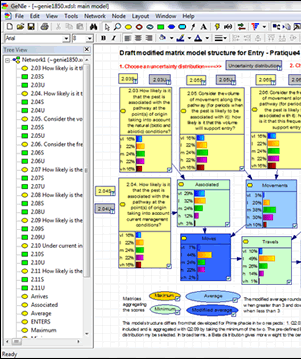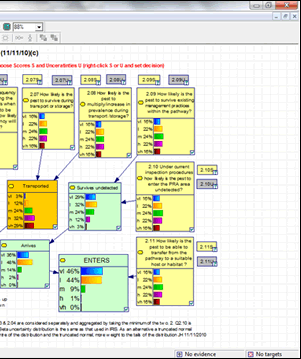
19th Meeting of the Panel on PRA Development
Paris, 2011-01-25/28
The 20th Meeting of the Panel on PRA Development was held in Paris on 2011-01-25/28. As for the previous meeting, the work was focused on reviewing the results of the EU project on PRA, 'PRATIQUE' in which EPPO is involved. The meeting therefore considered the outcomes of the project, but any changes to be implemented in the EPPO Decision-Support Scheme (EPPO DSS, PM5/3(4)) would only be made after the end of the PRATIQUE project in May 2011.


General discussions
The Panel discussed the Recommendation of the Working Party to perform fast PRAs. It was noted that in the EPPO framework there is no guidance for a rapid assessment of the risk when a new outbreak is found in a country, or when repeated interceptions are made on imported consignments. A fast PRA is needed to justify phytosanitary measures to be taken rapidly (i.e. within few weeks) before a detailed PRA is made. The Secretariat will convene a small EWG to draft guidelines for fast PRA for emergency situations.
The report of the PRATIQUE EPPO Workshop for PRA organized in Hammamet (TN) on 2010-11-23/26 to test the different deliverables of this project was presented.
The outcome of a meeting with the EU Standing Committee on Plant Health (SCPH) and the results of a questionnaire sent following this were presented and discussed. An update of the EFSA activities on PRA was presented by Ms Cheek (EFSA Plant Health Unit).
Results of different Work Packages (WP) within PRATIQUE
WP 2 – Enhancing techniques for economic, environmental and social impacts
One of the tasks of WP2 is to determine the key indicators required for impact assessment and to develop a quantitative scoring system for these indicators that can be related to the five levels of scoring required for each question in the EPPO PRA scheme (minimal, minor, moderate, major or massive). During the previous Panel meeting, a qualitative model was tested and the revisions made after the Panel were tested in the PRATIQUE EPPO Workshop for PRA organized in November 2010.
The Panel discussed how to take time and climate change into account in the PRA. The Panel concluded that climate change should not be considered to determine the time horizon of the PRA, as the time horizon to perform a PRA and the time horizon of climate change are different. The maximum time horizon should be estimated in the spread section, and if this is not possible different scenarios could be envisaged.
In the qualitative scheme for economic impacts, most questions were modified according to the team of economists’ suggestions, some questions were added and rating guidance for qualitative scores were provided directly with examples taken from the PRAs for Rhabdoscelus obscurus, Raoiella indica, Drosophila suzukii and Hydrocotyle ranunculoides. Indicators (e.g. percentage of the reduction in yield and quality) were also provided.
A decision tree to help assessors evaluate compensation mechanisms was included. The Panel appreciated the approach which was considered to be simple. This decision tree could form the basis of rating guidance that shall be explored by economists during the next PRATIQUE meeting.
The qualitative economic impact assessment model is programmed with the Bayesian Belief Network methodology and uses matrices. The module combines answers to questions considering economic impact.
The quantitative economic impact assessment module was also presented and the data needed for Partial Budgeting include the total production value, the proportion of area infested, the proportion of the damage in the infested area, and additional production costs. A revised document will be presented to the next PRATIQUE meeting.
Considering social impacts, the note had been restructured to include landscape effects (i.e. the land use function such as agriculture, living area); social contribution such as aesthetic value, (cultural-) historic value, loss of employment, effects on human health, and products and services. A quantitative module is under development.
The Panel was appreciative of the tools developed.
The environmental impact assessment section of the scheme will be further tested by experts of the Panel on Invasive Alien Species.
WP 3 – Enhancing techniques for standardising and summarising pest risk assessments & dealing with uncertainty
Tools for visualising and summarising risk and uncertainty have been developed.
- Rating guidance
Rating guidance to provide consistency in the different assessments performed with the EPPO DSS, have been developed further, in particular for the establishment part of the scheme. The Panel welcomed the inclusion of more examples in the rating guidance.
- Visualization tool
A CAPRA (Computer Assisted PRA) version of the visualization tool was presented. This tool allows the assessor to see on a chart the value given for individual answers in a section (i.e. entry, establishment, spread or impact). The objective is to help to give a final score for each section. The Panel was very appreciative of the tool developed.
- Matrices
A matrix model approach has been developed. Matrices summarize a set of rules (e.g. if the answer to a question is very unlikely and to another question likely then the result is e.g. moderately likely). Different models have been developed for entry, establishment, spread and impact (both environmental and other economic impacts). Matrices developed are based on the existing scheme; the response to 2 individual questions (the rating being transformed to a 1 to 5 scale point) and level of uncertainty given generate the combined risk representation. Depending on the questions and their relationships, different types of matrices are chosen to combine the ratings from different questions (e.g. minimum matrix may be appropriate when the response to either question acts as a powerful constraint to the final result). It was concluded that the models should be tested further with more species. The Panel suggested developing matrix models at a higher level (i.e. for the combination of entry and establishment).
- IRIS (Invasive Risk Impact Simulator)
IRIS is a tool developed to interpret the scores given by assessors for the four components of Entry, Establishment, Spread and Impact. IRIS allows risks posed by different species to be compared on a single graph. The Panel considered that more guidance and examples need to be included to ensure that appropriate input value are selected and the result correctly interpreted by risk managers. It preferred IRIS to be used as an additional tool that can be provided to risk assessors.
- Pest risk mapping
Pest risk maps are increasingly being used in risk analysis, but they should be used with caution as they require considerable modelling and mapping skills, resources and time and can be misinterpreted. CLIMEX guidance had also been developed to enable risk managers and others to interpret CLIMEX maps. A Decision Support Scheme for climatic mapping has therefore been developed in the framework of PRATIQUE with the objective to consider when mapping is appropriate, but also to help assess information availability and to relate it to the performance of different methods. In addition, a draft tutorial on climatic mapping techniques in PRA has been produced and describes various models (e.g. Diva-GIS, Maxent, Openmodeller Desktop, and CLIMEX), how to use them, and how to compare regression model outputs (e.g. using ROC analysis).
Besides mapping the climatic conditions, a Decision Support Scheme to map the endangered area is also being developed within PRATIQUE. The software MCAS-S (Multi-Criteria Analysis Shell for Spatial decision support) has a user friendly interface and can be used to view and classify different types of mapped information, to combine map layers in ways that provide insight into key relationships and questions, and quickly and simply produces statistical reports for regions. The different risk matrices that can be used and their consequences on the final maps are being considered. The example of Diabrotica virgifera was shown.
The Panel was appreciative of the new tools developed, but considered that their use required expertise on mapping and was limited by the availability of basic data at the level of the European Union such as maps of hosts.
- Restructuring of the establishment section
A new structure of the establishment section was proposed. For seven factors (host plants and suitable habitats, alternate hosts and other essential species, climatic suitability, other abiotic factors, competition and natural enemies, managed environment, protected cultivation), the assessor should first decide whether these are likely to have an influence on the limits, and then on the suitability of the area of potential establishment. The Panel reviewed and tested the restructuring with the examples of Agrilus anxius, a wood borer affecting birch trees and Drosophila suzukii a drosophilidae attacking healthy fruits for which PRAs were recently conducted in the EPPO framework. Several comments were made and a revised version of the establishment section will be prepared to be discussed at the next PRATIQUE meeting.
- Revision of the qualitative scheme for spread
The main change to the spread section is the requirement that the assessor should give an estimation of the time frame for invasion of the endangered area, choosing between 5 categories. A proportion of the area that he/she considered will be invaded in a given time scale should also be evaluated.
These questions were considered difficult and should be discussed again at the PRATIQUE meeting. Detailed suggestions were made on the questions on natural and human aided spread and will be incorporated in a revised version (as for natural spread the mean rate should be taken into account rather than the maximum rate).
WP 6 - Project validation and dissemination with the development of a web-based PRA scheme
The new version of the computer programme CAPRA (Computer Assisted PRA) was presented to the Panel. The computer programme is a web downloadable standalone version that has to be installed on individual computers. All sections of the EPPO Decision-Support Scheme for quarantine pests are included and hyperlinks to the definitions of terms of the Glossary of phytosanitary terms (ISPM No.5) are available. The different sections of the EPPO DSS can be performed independently and no longer need to be completed in a fixed sequence. The programme is at present only available for download to PRATIQUE partners, EPPO Panels and Expert Working Groups but shall be made publicly available at the end of the PRATIQUE project.
WP 4 - Enhancing techniques for pathway analysis and systems approaches:
Protocol for guidance for scoring level of risk within the EPPO DSS entry section
Few changes were made to questions in the entry section of the current scheme but some questions were merged into one (e.g. those related to the transfer). All the questions were reworded so that they are answered in terms of likelihood and magnitude. Most experts present were in favour of these changes. Generally experts considered that more guidance should be incorporated in the future. It was concluded that some final attempts to provide more guidance should be made at the next PRATIQUE meeting.
Revision of the management section of the EPPO DSS
In the revised version, the sequences of measures are now analysed according to the production/transport chain of the commodity (from the place of production to harvest, packing, transport, and post-import) to make it easier to identify combinations of measures and determine how they could operate on the pathway. The questions have been reorganized but remain substantially unchanged. The Panel welcomed the new structure although it was commented that guidance is still lacking. The revision of the management section of the EPPO DSS should be presented to the Panel on Phytosanitary Measures. The suggestion to replace the current management part with the revised one already in 2011 will be discussed at this occasion.
